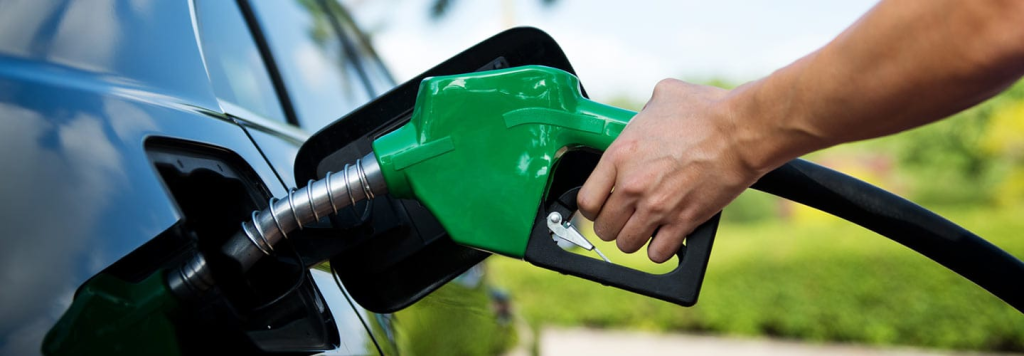- Vehicles
- Buying
- Engineering
- Owner
-
-
Quality Part & Collection
- Brake
- Battery
- Ford Genuine Parts
-
-
-
SYNC Support
- SYNC™ Support
- SYNC™ 2 Support
- SYNC™ 3 Support
-
Contact Us
- Ford Call Center
-
- Ford Owners Club Myanmar
- About Ford
- Test Drive
- Brochure
Vehicle Support | User Tips
Vehicle Support | User Tips
Menu
Close
USER TIPS

Driving Skills and Tips:
Right Time for Refueling
It is usual to refuel a car in use. However, not all drivers know the right time for refueling that can save you money and effectively protect some car parts and will not harm your health. The following instructions give you some helpful tips.
Money Saving
1) Avoid refueling under the burning sun. When the ambient temperature is high, the oil storage and the pipe are also subject to a high temperature and plentiful gasoline vapor will be generated, so the gasoline from the oil gun will reduce due to gasoline evaporation. Therefore, the right time for refueling is morning or night.
2) Do not always top up the tank full except during long-distance travels. When a fuel tank is filled up, the car weight will naturally increase. If you often drive short distances, the excessive fuel weight is equivalent to a person’s weight and the car will surely consume more fuel. So it is not necessary to top up full every time.
1) Avoid refueling under the burning sun. When the ambient temperature is high, the oil storage and the pipe are also subject to a high temperature and plentiful gasoline vapor will be generated, so the gasoline from the oil gun will reduce due to gasoline evaporation. Therefore, the right time for refueling is morning or night.
2) Do not always top up the tank full except during long-distance travels. When a fuel tank is filled up, the car weight will naturally increase. If you often drive short distances, the excessive fuel weight is equivalent to a person’s weight and the car will surely consume more fuel. So it is not necessary to top up full every time.
Part Life
1) The gasoline pump is installed inside the fuel tank and will be “soaked” in the gasoline during operation to dissipate heat via the gasoline. If a car is often refueled when its gasoline is nearly used up, the life of the gasoline pump may be shortened due to bad heat dissipation.
2) When a fuel tanker is supplementing the oil storage in a station, do not refuel at this station at that moment. When a fuel tanker is supplementing the oil storage, the sediments at the oil storage will be rushed up. Deposited sundries will block the fuel pipeline, and it will lead to failed operation of an engine or other failures.
1) The gasoline pump is installed inside the fuel tank and will be “soaked” in the gasoline during operation to dissipate heat via the gasoline. If a car is often refueled when its gasoline is nearly used up, the life of the gasoline pump may be shortened due to bad heat dissipation.
2) When a fuel tanker is supplementing the oil storage in a station, do not refuel at this station at that moment. When a fuel tanker is supplementing the oil storage, the sediments at the oil storage will be rushed up. Deposited sundries will block the fuel pipeline, and it will lead to failed operation of an engine or other failures.
Body Health
The volatiles of gasoline include some carcinogens such as benzene, methyl benzene, dimethyl benzene and ethylbenzene. If you are often exposed to these volatiles, they will harm your health. The following introduces some methods to avoid it.
1) Do not refuel in daytime under a high temperature as much as possible because a high temperature will lead to more volatiles of gasoline.
2) Do not refuel more after the fuel tank is full. When the fuel tank is 80% full, the oil gun will automatically shut off because the gasoline gas inside the fuel tank is saturated. To continue refueling, the oil gun shall be drawn out. After the gasoline gas overflows out of the fuel tank, the gasoline can be further refueled. The overflowed gasoline gas could be inhaled by people nearby. Therefore, after the oil gun shuts off, do not continue refueling.
3) When you smell gasoline during driving, pull over immediately and check if the oil tank cover is tightened. If you still smell gasoline, be sure to have the car checked at a profession service plant.
4) After refueling, do not stay in the nearby area for a long period.
5) Turn off your mobile phone before entering a gasoline station. Making or answering a phone call could potentially cause a fire. It should also be noted that the engine should be shut down and the ignition key should be turned to the off position.
The volatiles of gasoline include some carcinogens such as benzene, methyl benzene, dimethyl benzene and ethylbenzene. If you are often exposed to these volatiles, they will harm your health. The following introduces some methods to avoid it.
1) Do not refuel in daytime under a high temperature as much as possible because a high temperature will lead to more volatiles of gasoline.
2) Do not refuel more after the fuel tank is full. When the fuel tank is 80% full, the oil gun will automatically shut off because the gasoline gas inside the fuel tank is saturated. To continue refueling, the oil gun shall be drawn out. After the gasoline gas overflows out of the fuel tank, the gasoline can be further refueled. The overflowed gasoline gas could be inhaled by people nearby. Therefore, after the oil gun shuts off, do not continue refueling.
3) When you smell gasoline during driving, pull over immediately and check if the oil tank cover is tightened. If you still smell gasoline, be sure to have the car checked at a profession service plant.
4) After refueling, do not stay in the nearby area for a long period.
5) Turn off your mobile phone before entering a gasoline station. Making or answering a phone call could potentially cause a fire. It should also be noted that the engine should be shut down and the ignition key should be turned to the off position.
Precautions for Fording Drive
Flooded roads are common in rainy and typhoon seasons, especially at low areas and underpasses, so you must be very careful at these places or the engine may be severely damaged. The engine inlets of most cars are located above or at the center of the front bumper. If the flood water approximates to the bumper, it may easily get into the engine and damage the engine. Because water cannot be compressed, and when some water enters a cylinder, the crankshaft connecting rod will be bent and fractured due to the pressure caused by the water, and the engine cylinder body can break.
If the water level in flooded area exceeds one-second of the height from the ground to the wheel center, do not drive through this area. Otherwise, the engine may be severely damaged.
To determine a secure fording position of a car, use the wheel. The one-second of the height from the ground to the wheel center is taken as the benchmark point. If the water is above the benchmark point, do not take the risk of fording. If the water is under the benchmark, refer to the following suggestions:
1) When you approach a flooded road and the water depth cannot be determined, you are recommended to find another route, or pull over to watch what happens to other vehicles as they drive through the water and then make your decision.
2) If the flood water does not exceed the wheel benchmark, you shall ford in the following way: before starting the car, turn off the air-conditioner and switch to the low gear, and then lightly step on the accelerator and hold it. Do not release the accelerator, or the water will be sucked into the engine due to the back pressure of the exhaust pipe, so that the engine will be severely damaged. Lightly step on the accelerator and pass through the flooded road at a steady and slow pace.
3) Keep at least one-car length of distance from the car in front of you during fording to prevent the splashing water from being sucked into the engine via the inlet. Do not drive too fast during fording. If you step too heavily on the accelerator, the throttle will suck much air under big openness and the water is easy to get into the engine in this case, thus damaging the engine. If the engine flames out during fording, do not try to start the engine again. At this point, the engine flames out for two reasons: improper operation or water inhaled into the engine. If you restart the engine, it will be severely damaged. The correct method is to immediately contact a professional service plant for help or find a tow truck to tow the car to the nearest 4S store.
After you pass through the flooded area, light brake applications will help the wet brake blocks and brake discs dry out quickly to ensure normal braking function.
If the water level in flooded area exceeds one-second of the height from the ground to the wheel center, do not drive through this area. Otherwise, the engine may be severely damaged.
To determine a secure fording position of a car, use the wheel. The one-second of the height from the ground to the wheel center is taken as the benchmark point. If the water is above the benchmark point, do not take the risk of fording. If the water is under the benchmark, refer to the following suggestions:
1) When you approach a flooded road and the water depth cannot be determined, you are recommended to find another route, or pull over to watch what happens to other vehicles as they drive through the water and then make your decision.
2) If the flood water does not exceed the wheel benchmark, you shall ford in the following way: before starting the car, turn off the air-conditioner and switch to the low gear, and then lightly step on the accelerator and hold it. Do not release the accelerator, or the water will be sucked into the engine due to the back pressure of the exhaust pipe, so that the engine will be severely damaged. Lightly step on the accelerator and pass through the flooded road at a steady and slow pace.
3) Keep at least one-car length of distance from the car in front of you during fording to prevent the splashing water from being sucked into the engine via the inlet. Do not drive too fast during fording. If you step too heavily on the accelerator, the throttle will suck much air under big openness and the water is easy to get into the engine in this case, thus damaging the engine. If the engine flames out during fording, do not try to start the engine again. At this point, the engine flames out for two reasons: improper operation or water inhaled into the engine. If you restart the engine, it will be severely damaged. The correct method is to immediately contact a professional service plant for help or find a tow truck to tow the car to the nearest 4S store.
After you pass through the flooded area, light brake applications will help the wet brake blocks and brake discs dry out quickly to ensure normal braking function.
Tips for Manual Gear Shift
A manual transmission is mechanically controlled, which is different in gear shift from an automatic transmission controlled in a hydraulic-electronic manner. To protect the transmission and the clutch and maximize their value and life, the following precautions should always be taken:
1. The transmission is operating at a high rate when a car is moving. Generally, you should press down the clutch as far as possible before shifting gears so as to prevent damage to the transmission due to incomplete separation of the clutch.
2. Generally, when driving fast (above 30 km/h) in a high gear (gear 3 and higher), you are not permitted to shift to gear 1, because the great shifting force will lead to severe wear of the simultaneous observation loop.
3. Generally, when shifting from a high gear to gear 2, you are recommended to travel at a speed lower than 20 km/h and to gear 1 at a speed lower than 10 km/h.
1. The transmission is operating at a high rate when a car is moving. Generally, you should press down the clutch as far as possible before shifting gears so as to prevent damage to the transmission due to incomplete separation of the clutch.
2. Generally, when driving fast (above 30 km/h) in a high gear (gear 3 and higher), you are not permitted to shift to gear 1, because the great shifting force will lead to severe wear of the simultaneous observation loop.
3. Generally, when shifting from a high gear to gear 2, you are recommended to travel at a speed lower than 20 km/h and to gear 1 at a speed lower than 10 km/h.

